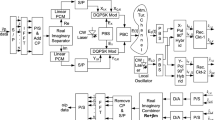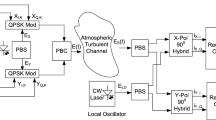Abstract
The performance of polarization division- multiplexing (PDM) and differential phase-shift keying (DPSK) modulated signal transmission over slow, varying turbulence channels is estimated in this paper. The free-space optical channel is simulated using the stochastic differential equation (SDE)-based numerical channel simulator that considers the channel’s temporal correlation effect. The SDE-based channel simulator model may significantly ease the free space optical (FSO) communication system design and enable the simulation of channel states according to predefined first- and second-order statistics, namely channel distribution and auto-covariance. We report the performance comparison of the PDM-DPSK system over an uncorrelated, fast-varying FSO channel and a time-correlated, slow-varying channels. Furthermore, to incorporate the effects of polarization and phase fluctuations in the FSO link, both time-dependent and Gaussian distributed, simulated using SDE methods. The bit error rate (BER) performance obtained from the numerical simulation of the PDM-DPSK system shows that the impact of intensity fluctuations is more severe than polarization and phase fluctuations. The power penalty relative to back-to-back (B2B) is 0.5 dB, 2.5 dB, and 7 dB for a 1 km FSO link to achieve a threshold BER of \(10^{-3}\) for weak, moderate and strong turbulence conditions, respectively, for a slow-varying turbulence channel. We find that the PDM-DPSK link cannot achieve the threshold BER value for fast-changing turbulent channels, particularly for medium and strong turbulence. For weak turbulence, 2 dB more received power is required to achieve the threshold BER value. Thus, the measured BER performances of the PDM-DPSK systems over a fast-varying turbulent channel are overestimated, which does not provide the actual link performance over the time-correlated turbulent channel.








Similar content being viewed by others
Data availability
The data-sets generated during and/or analyzed during the current study are available from the corresponding author on reasonable request.
References
Al-Habash, A., Andrews, L.C., Phillips, R.L.: Mathematical model for the irradiance probability density function of a laser beam propagating through turbulent media. Opt. Eng. 40(8), 1554–1563 (2001)
Andrews, L.C., Phillips, R.L.: Laser Beam Propagation through Random Media. Second Edition, Laser Beam Propagation Through Random Media (2005)
Andrews, L.C., Phillips, R.L., Hopen, C.Y.: Laser beam scintillation with applications, vol. 99. SPIE press, USA (2001)
Anguita, JA., Cisternas, JE.: Turbulence strength and temporal correlation in a terrestrial laser communication link. In: Free-Space Laser Communications X, International Society for Optics and Photonics, vol 7814, p 78140H (2010)
Bykhovsky, D.: Free-space optical channel simulator for weak-turbulence conditions. Appl. Opt. 54(31), 9055–9059 (2015)
Bykhovsky, D.: Simple generation of gamma, Gamma–Gamma, and k distributions with exponential autocorrelation function. J. Lightw. Technol. 34(9), 2106–2110 (2016)
Chan, V.W.: Free-space optical communications. J. Lightw. Technol. 24(12), 4750–4762 (2006)
Churnside, J.H.: Aperture averaging of optical scintillations in the turbulent atmosphere. Appl. Opt. 30(15), 1982–1994 (1991)
Gao, Duorui., et al.: High-sensitivity multi-channel DPSK system with real-time phase lock controller for free-space optical communication. Front. Phys. :736 (2022)
Ghassemlooy, Z., Tang, X., Rajbhandari, S.: Experimental investigation of polarisation modulated free space optical communication with direct detection in a turbulence channel. IET Commun. 6(11), 1489–1494 (2012)
Ghassemlooy, Z., Popoola, W., Rajbhandari, S.: Optical wireless communications: system and channel modelling with Matlab® CRC press (2019)
Ho, K.P.: Phase-modulated optical communication systems. Springer, Berlin (2005)
Hutt, D.L.: Modeling and measurement of atmospheric optical turbulence over land. Opt. Eng. 38(8), 1288–1295 (1999)
Jeon, HB., Kim, SM., Moon, HJ., Kwon, DH., Lee, JW., Chung, JM., Han, SK., Chae, CB., Alouini, MS.: Free-space optical communications for 6g-enabled long-range wireless networks: challenges, opportunities, and prototype validation. (2022) arXiv preprint arXiv:2209.07674
Khalighi, M.A., Uysal, M.: Survey on free space optical communication: a communication theory perspective. IEEE Commun. Surveys Tutor. 16(4), 2231–2258 (2014)
Khatib, M.: (Ed.). Contemporary issues in wireless communications. BoD-Books on Demand (2014)
Kontorovich, V.Y., Lyandres, V.Z.: Stochastic differential equations: an approach to the generation of continuous non-gaussian processes. IEEE Trans. Signal Process. 43(10), 2372–2385 (1995)
Latal, Jan., et al.: Measurement of changes of polarization of optical beam affected by atmospherically effects. In: 2017 19th International Conference on Transparent Optical Networks (ICTON), IEEE (2017)
Li, M., Li, B., Zhang, X., Song, Y., Chang, L., Chen, Y.: Investigation of the phase fluctuation effect on the ber performance of dpsk space downlink optical communication system on fluctuation channel. Opt. Commun. 366, 248–252 (2016)
Li, K., Lin, B., Ma, J.: Dpsk modulated multiple apertures receiver system for satellite-to-ground heterodyne optical communication. Opt. Commun. 454, 124466 (2020)
Navidpour, S.M., Uysal, M., Kavehrad, M.: BER performance of free-space optical transmission with spatial diversity. IEEE Trans. Wirel. Commun. 6(8), 2813–2819 (2007)
Nguyen, T.V., Le, H.D., Dang, N.T., Pham, A.T.: On the design of rate adaptation for relay-assisted satellite hybrid fso/rf systems. IEEE Photon. J. 14(1), 1–11 (2021)
Nguyen, TV., Le, HD., Pham, AT.: On the design of ris-uav relay-assisted hybrid fso/rf satellite-aerial-ground integrated network. IEEE Transactions on Aerospace and Electronic Systems (2022)
Primak, S., Lyandres, V., Kontorovich, V.: Markov models of non-gaussian exponentially correlated processes and their applications. Phys. Rev. E 63(6), 061103 (2001)
Sangeetha, R.G., Hemanth, C., Jaiswal, I.: Performance of different modulation scheme in free space optical transmission-A review. Optik 254, 168675 (2022)
Schranz, Ágoston., Udvary, Eszter: Error probability in polarization sensitive communication systems in terms of moments of the channel’s rotation angle. Opt. Quantum Electron. 53, 1–21 (2021)
Shin, W.H., Choi, J.Y., Han, S.K.: Fixed threshold on-off keying differential detection for satellite optical communications. Opt. Express 27(2), 1590–1596 (2019)
Shukla, A.M., Gupta, S.: Experimental demonstration: differential detection of 10 gbps optical ook signal over turbulent channel. Optik 266, 169564 (2022)
Shukla, AM., Gupta, S.: Simultaneous measurement of atmospheric turbulence induced intensity and polarization fluctuation for free space optical communication. In: 2020 National Conference on Communications (NCC), IEEE, pp 1–4 (2020)
Tripathi, A., Soni, G.G., Gupta, S., Mandloi, A.S.: Experimental investigation of wind and temperature induced scintillation effect on optical wireless communication link. Optik 178, 1248–1254 (2019)
Tsiftsis, T.: Performance of heterodyne wireless optical communication systems over Gamma–Gamma atmospheric turbulence channels. Electron. Lett. 44(5), 1 (2008)
Viswanathan, H., Mogensen, P.E.: Communications in the 6g era. IEEE Access 8, 57063–57074 (2020)
Vitásek, J., Látal, J., Hejduk, S., Bocheza, J., Koudelka, P., Skapa, J., Vašinek, V.: (August). Atmospheric turbulences in free space optics channel. In 2011 34th International Conference on Telecommunications and Signal Processing (TSP) (pp. 104-107). IEEE (2011)
Xie, G., Dang, A., Guo, H.: Effects of atmosphere dominated phase fluctuation and intensity scintillation to dpsk system. In: 2011 IEEE International Conference on Communications (ICC), IEEE, pp 1–6 (2011)
Xu, Z., Xu, G., Zheng, Z.: Ber and channel capacity performance of an fso communication system over atmospheric turbulence with different types of noise. Sensors 21(10), 3454 (2021)
Zhang, J., Ding, S., Zhai, H., Dang, A.: Theoretical and experimental studies of polarization fluctuations over atmospheric turbulent channels for wireless optical communication systems. Opt. Express 22(26), 32482–32488 (2014)
Zhang, J., Li, R., Dang, A.: Experimental studies of phase fluctuations in free-space optical communications. In: Applications of Lasers for Sensing and Free Space Communications, Optical Society of America, pp LTh2D–3 (2015)
Zhou, H., Xie, W., Zhang, L., Bai, Y., Wei, W., Dong, Y.: Performance analysis of fso coherent bpsk systems over rician turbulence channel with pointing errors. Opt. Express 27(19), 27062–27075 (2019)
Funding
The authors have not disclosed any funding.
Author information
Authors and Affiliations
Contributions
All authors contributed to the study conception and design. Analysis were performed by AMS. The first draft of the manuscript was written by AMS. SG reviewed and commented on final manuscript.
Corresponding author
Ethics declarations
Conflict of interest
The authors declare that they have no known competing financial interests or personal relationships that could have appeared to influence the work reported in this paper.
Ethical approval
Not Applicable.
Additional information
Publisher's Note
Springer Nature remains neutral with regard to jurisdictional claims in published maps and institutional affiliations.
Rights and permissions
Springer Nature or its licensor (e.g. a society or other partner) holds exclusive rights to this article under a publishing agreement with the author(s) or other rightsholder(s); author self-archiving of the accepted manuscript version of this article is solely governed by the terms of such publishing agreement and applicable law.
About this article
Cite this article
Shukla, A.M., Gupta, S. Performance estimation of polarization multiplexed DPSK signal transmission over temporally correlated free space optical channel. Opt Quant Electron 55, 806 (2023). https://doi.org/10.1007/s11082-023-05087-y
Received:
Accepted:
Published:
DOI: https://doi.org/10.1007/s11082-023-05087-y




